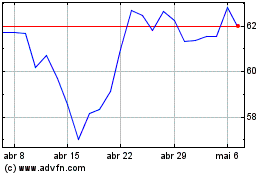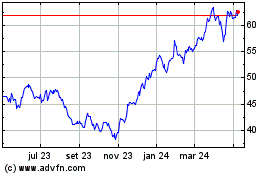Citi Launches New Report on Global Supply Chain Disruptions
15 Dezembro 2021 - 7:00AM
Business Wire
Latest Report analyses the impact supply chain
disruptions has had across multiple sectors
Citi has today launched its latest Global Perspectives &
Solutions (Citi GPS) report titled: Global Supply Chains: The
Complicated Road Back to “Normal.”
The report details the challenges that have emerged for supply
chains as a result of the COVID-19 pandemic and highlights the
hardest hit sectors and what their road to recovery looks like.
The report identifies a number of macroeconomic factors that
came into play during the pandemic to disrupt supply chains
including supply-chain management practices, shifts in consumption
towards goods, monetary and fiscal stimulus by the public sector
spurring aggregate demand, the emergence of the Delta variant, and
commodity shocks that have amplified other supply-side pressures.
It also acknowledges the speed at which these disruptions have
cascaded around the world.
Nathan Sheets, Citi’s Global Chief Economist, commented: “The
pandemic brought a sustained substitution in consumer spending
towards goods. Coupled with the sizable macroeconomic stimulus,
this has driven the demand for goods well above supply in many
sectors. The recovery from the pandemic, as well as the actions
taken to support the economy, have created a situation where the
demand for goods has run well ahead of their supply. The resulting
supply-side disruptions are, at least in part, the result of firms
desperately trying to catch up.”
The report goes on to say that supply-chain pressures are at a
point where they have stopped getting worse; however, there is
currently no sign of any substantial improvements. It argues that
the global inventory system was not designed to absorb the highly
uneven stops and starts in demand and production that the pandemic
has caused, and notes that the ongoing global vaccination campaign
is a critical contributor to an eventual easing of supply-chain
pressures.
Shahmir Khaliq, Global Head of Citi’s Treasury and Trade
Solutions, commented: “The supply chain disruptions globally are
the byproduct of multiple events including national lockdowns, port
congestion, and labor and energy shortages, layered on top of
rising geopolitical tensions. As different parts of the world
reopen their borders, lift restrictions, and resume manufacturing
operations, we see an imbalance of supply and demand in the market.
Suppliers and sellers are struggling to keep up with the demand
from reopened economies.”
The report advises that corporates will need to review their
supply chains based on lessons learned from the pandemic. Doing
this will likely lead to a further embrace of digitization and
electronic tracking of inventories and logistics, greater emphasis
on long-term alliances and partnerships with suppliers, inventory
management strategies that shift towards holding larger inventory
buffers, simplifying supply chains and bringing them closer to
home, as well as a reduction in global integration, as nations try
to protect their national economies from the next shock.
Shahmir Khaliq continues: “Even before the pandemic, we had
witnessed a major acceleration in the adoption of technology,
including digitization, data analysis, and tools like application
programming interfaces (APIs). COVID-19 has emphasized the benefits
of this adoption on many levels. Citi has continued to push
innovation, investing in digital solutions to enhance the client
onboarding and implementation experience, develop new self-service
capabilities, and leverage data to empower clients.”
The digital copy of the report is available here
-ENDS-
About Citi
Citi, the leading global bank, has approximately 200 million
customer accounts and does business in more than 160 countries and
jurisdictions. Citi provides consumers, corporations, governments
and institutions with a broad range of financial products and
services, including consumer banking and credit, corporate and
investment banking, securities brokerage, transaction services, and
wealth management.
Additional information may be found at www.citigroup.com |
Twitter: @Citi | YouTube: www.youtube.com/citi | Blog:
blog.citigroup.com | Facebook: www.facebook.com/citi | LinkedIn:
www.linkedin.com/company/citi
View source
version on businesswire.com: https://www.businesswire.com/news/home/20211215005402/en/
Belinda Marks Belinda.marks@citi.com Gabe Morales
gabriel.morales@citi.com Nina Das nina.das@citi.com Francesco
Meucci Francesco.meucci@citi.com
Citigroup (NYSE:C)
Gráfico Histórico do Ativo
De Mar 2024 até Abr 2024

Citigroup (NYSE:C)
Gráfico Histórico do Ativo
De Abr 2023 até Abr 2024
